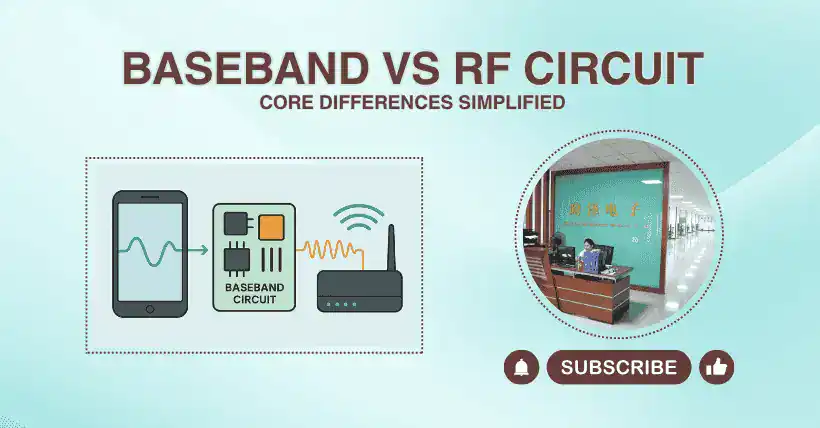01
What is “Baseband”?
The term “baseband” originated from communication theory, referring to unmodulated original signals. For example, the sound of your voice during a phone call, the image signal in a video call, and data packets transmitted through a network port—all of these are “baseband signals.”
02
What does a baseband circuit do?
In simple terms, a baseband circuit’s task is to “generate, process, and control these original low-frequency information signals.”
In a wireless communication system—whether it’s a phone, router, Bluetooth headset, or in-car navigation—the entire system can be divided into two core modules:
- Baseband system: Responsible for processing original data and control logic; it functions like the “brain”
- RF system: Responsible for wirelessly “transmitting” the processed data or “demodulating” the signals received by the antenna
03
What components are included in a baseband circuit? (Key point)
Baseband circuits are a mix of digital and analog circuits, mainly composed of the following core modules:
- Digital Processing Module (Digital Baseband)
Such as CPUs, DSPs, FPGAs, and dedicated communication processing chips (SoC) Used to execute communication protocols, modulation/demodulation algorithms, encryption/decryption, data packing/unpacking, etc. For example: OFDM modulation in Wi-Fi, channel coding in 5G, and signal pairing in Bluetooth—all are done here - Analog Interface Module (Analog Baseband)
This part connects to the low-frequency analog interfaces of RF circuits, such as DACs (digital-to-analog converters), ADCs (analog-to-digital converters), low-pass filters, and mixers (in intermediate frequency designs) For example, an audio signal is first converted to digital via an ADC for digital module processing, then output through a DAC to an amplifier or headphone - Memory and Control Module
Includes DDR, Flash, EEPROM, etc., used to store programs, buffer data, and save settings An MCU (microcontroller) is also typically part of the baseband system, used for overall control, power management, temperature monitoring, clock synchronization, etc. - Power Management and Clock System
Baseband chips require stable voltage and precise clocks to function (e.g., 26MHz or 40MHz crystals) The power module provides multiple regulated power supplies, while the clock module provides system frequencies and synchronization signals - Interface Circuit
Includes physical interfaces for external communication, such as USB, PCIe, I2C, SPI, UART, SDIO, etc. For example, a Wi-Fi chip communicates with the main SoC via SDIO; these interfaces are part of the baseband circuit
04
Differences Between Baseband and RF Circuits
| Comparison Item | Baseband Circuit | RF Circuit |
|---|---|---|
| Main Signal Type | Digital signals / low-frequency analog | High-frequency analog signals (electromagnetic) |
| Operating Frequency | Several Hz ~ Hundreds of MHz (often MHz~GHz) | Usually hundreds of MHz to tens of GHz |
| Main Purpose | Data processing, control logic, modulation/demodulation | Power control, signal transmission and reception |
| Testing Tools | Oscilloscope, logic analyzer, protocol analyzer | Spectrum analyzer, network analyzer, RF tester |
| Common Chips | SoC, Modem, MCU, DAC, ADC, memory, etc. | PA, LNA, Switch, SAW filters, antennas, etc. |
05
A Simple Example
Take a smartphone for example:
When you speak, the microphone captures your voice. The baseband circuit converts it into a digital signal → encodes → encrypts → processes modulation → hands it to the RF circuit for transmission.
When receiving a call, the RF circuit picks up the signal from the antenna → demodulates → sends to the baseband circuit → decrypts → decodes → restores the voice → plays it out.
In this process, the baseband circuit acts as the brain and internal organs of the communication system, responsible for thinking, computing, and processing various information; the RF circuit is like its ears and mouth, responsible for “listening” and “speaking.”
06
In Summary:
The baseband circuit is the “central nervous system” of a communication system, specialized in processing original data and control logic. It is the fundamental guarantee for the normal operation of all wireless communication devices.
Related:

Disclaimer: This article is created by the original author. The content of the article represents their personal opinions. Our reposting is only for sharing and discussion purposes and does not imply our endorsement or agreement. If you have any objections, please get in touch with us through the provided channels.



